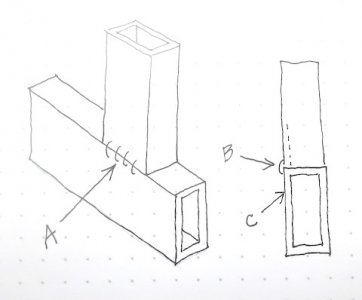- Joined
- Feb 24, 2015
- Messages
- 1,382
I had a project where I needed to weld some 1" x 2" x 1/8" aluminum rectangular tube. I utterly failed to do it.
I'm not much of a TIG welder but I can make fairly good looking welds on butt and T joints an varying thicknesses of material Using my Miller Syncrowave 210.
This is a diagram of the weld I was trying to make.

No matter how many times I tried, all could do was mess it up. I used up dozens of test pieces.
I practiced on this a day and a half and finally had to give up and make mechanical connections.
I tried everything I could think of, concentrating the arc on the horizontal part, moving faster, slower and all kinds of adjustments to my arc.
What usually happened is when I got the horizontal hot enough, the vertical would melt and I'd end up with a horrible gloppy bead.
I suspect the problem was caused by the different relative thickness of material down the middle of my bead as on the right drawing (B and C), which is an end view of the pieces.
I'd love to be able to make this weld. I'm planning something now that I need to.
Any suggestions on how to make this would be greatly appreciated.
I'm not much of a TIG welder but I can make fairly good looking welds on butt and T joints an varying thicknesses of material Using my Miller Syncrowave 210.
This is a diagram of the weld I was trying to make.

No matter how many times I tried, all could do was mess it up. I used up dozens of test pieces.
I practiced on this a day and a half and finally had to give up and make mechanical connections.
I tried everything I could think of, concentrating the arc on the horizontal part, moving faster, slower and all kinds of adjustments to my arc.
What usually happened is when I got the horizontal hot enough, the vertical would melt and I'd end up with a horrible gloppy bead.
I suspect the problem was caused by the different relative thickness of material down the middle of my bead as on the right drawing (B and C), which is an end view of the pieces.
I'd love to be able to make this weld. I'm planning something now that I need to.
Any suggestions on how to make this would be greatly appreciated.

